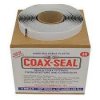So I'm about to install CCTV for the first time and I have a few questions. I've got some flexible steel conduit which is coated in pvc. I'm planning on connecting this to a plastic junction box with nylon glands. I will connect two to three camera's through this junction box. I'm using adjustable glands because the conduit is an unusual size (approx 14mm OD). Since the box is plastic and the glands are nylon it'll be difficult to ground. The conduit/ethernet cable will be running 30cm-2m above ground level across the walls of the house. I've never had lightning strike near my house but if it were to ever happen, would this be safe? I've read that metal conduit requires grounding but this is coated in pvc so not sure if that makes a difference.
Also, is it ok if I put silicone sealant around a hole in the back of the junction box and mount it directly to a brick wall and then take the wires through the hole from indoors. I want to make sure the box is waterproof so the conduit doesn't rust.
I'm also thinking of using a putty similar to blu tack but stronger to hold/seal the wire in the conduit where it connects inside the camera junction box (not the other junction box) just so it adds a bit of waterproofing incase some water does manage to find it's way in. This is to make sure the inside of the conduit doesn't come in contact with water/humidity and rust. Is this safe to do?
I came across a thread where someone said their junction box filled up with water after extreme weather. Someone recommended to put a small hole at the bottom of the junction box and to put sealant where the camera joins the box/box joins the wall but I won't be doing the latter as it'll be a headache when I eventually need to remove the camera. What are your thoughts on this?
Also, is it ok if I put silicone sealant around a hole in the back of the junction box and mount it directly to a brick wall and then take the wires through the hole from indoors. I want to make sure the box is waterproof so the conduit doesn't rust.
I'm also thinking of using a putty similar to blu tack but stronger to hold/seal the wire in the conduit where it connects inside the camera junction box (not the other junction box) just so it adds a bit of waterproofing incase some water does manage to find it's way in. This is to make sure the inside of the conduit doesn't come in contact with water/humidity and rust. Is this safe to do?
I came across a thread where someone said their junction box filled up with water after extreme weather. Someone recommended to put a small hole at the bottom of the junction box and to put sealant where the camera joins the box/box joins the wall but I won't be doing the latter as it'll be a headache when I eventually need to remove the camera. What are your thoughts on this?



